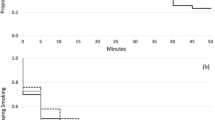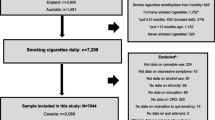Abstract
There have been few prospective studies of craving following smoking cessation. This paper presents findings from a prospective examination of factors associated with craving over an 8-week treatment period. Two findings merit attention: (1) dependence, as measured by the Dependence Index (DI), was associated with craving at 48 h, 4 and 8 weeks post-cessation. The magnitude of the association between the DI and short-term craving was, at the least, comparable to that previously reported among several biochemical measures of smoke intake; (2) a measure of craving obtained 48 h after smoking cessation was associated with treatment outcome. Forty-three per cent of participants with low initial craving scores were abstinent at a 2-month follow-up compared to only 26% of those with high craving scores. The DI was also associated with participants' status at follow-up. This result is interesting because evidence that craving or other abstinence effects are prospectively associated with outcome has been lacking.
Similar content being viewed by others
References
Butts WC, Kuehneman M, Widdowson GM (1974) Automated method for determining serum thiocyanate to distinguish smokers from nonsmokers. Clin Chem 20:1344–1348
Fagerstrom KO (1978) Measuring degree of physical dependence to tobacco smoking with reference to individualization of treatment. Addict Behav 3:235–241
Fortmann SP, Killen JD, Telch MJ, Newman B (1988) Minimal contact treatment for smoking cessation. JAMA 260:1575–1580
Hatsukami DK, Hughes JR, Pickens RW (1985) Blood nicotine, smoke exposure and tobacco withdrawal symptoms. Addict Behav 10:413–417
Hatsukami D, Hughes JR, Pickens R (1985) Characterization of tobacco withdrawal: physiological and subjective effects. In: Grabowski J, Hall SM (eds) Pharmacological adjuncts in smoking cessation. NIDA monograph #53, DHEW, PHS (ADM) 85–1333. US Gov't Printing Office, pp 56–67
Hughes JR, Higgens ST, Hatsukami D (1990) Effects of abstinence from tobacco. In: Kozlowski LT et al. (eds) Research advances in alcohol and drug problems, vol 10. Plenum Press, New York, pp 317–398
Killen JD, Fortman SP, Newman B, Varady A (1990) Evaluation of a treatment approach combining nicotine gum with self-guided behavioral treatments for smoking relapse prevention. J Consult Clin Psychol 58:85–92
Kozlowski LT, Wilkinson A (1987) Use and misuse of the concept of craving by alcohol tobacco and drug researchers. Bri J Addict 82:31–36
Leupker RV, Pechacek TF, Murray DM (1981) Saliva thiocyanate: a chemical indicator of cigarette smoking in adolescents. Am J Public Health 71:1320–1324
McNair DM, Lorr M, Droppleman LF (1981) Manual for the profile of mood states. Educational and Industrial Testing Service, San Diego, Ca
Ossip-Klein DJ, Bigelow G, Curry S, Hall S, Kirkland S (1986) Task Force 1: classification and assessment of smoking behavior. Proceedings of the National Working Conference on Smoking Relapse, Health Psychology 5 [Suppl]: 3–11
Russell MAH (1988) Nicotine replacement: the role of blood nicotine levels their rate of change and nicotine tolerance. In: Pomerleau OF, Pomerleau CS (eds) Nicotine replacement: a critical evaluation. Liss, New York, pp 63–94
Schneider N, Jarvik ME (1984) Time course of smoking withdrawal symptoms as a function of nicotine replacement. Psychopharmacology 82:143–144
Shiffman S (1979) The tobacco withdrawal syndrome. In: Krasnegor NA (ed) Cigarette smoking as a dependence process. NIDA Research Monograph #23, lashington DC, DHEW US Govt Printing Office, pp 158–184
Shiffman S (1986) A cluster-analytic classification of smoking relapse episodes. Addict Behav 11:295–307
Shiffman SM, Jarvik ME (1976) Smoking withdrawal symptoms in two weeks of abstinence. Psychopharmacology 50:35–39
Tiffany ST (1990) A cognitive model of drug urges and drug-use behavior: role of automatic and nonautomatic processes. Psychol Rev 97:147–168
West RJ, Russell MAH (1986) Pre-abstinence smoke intake and smoking motivation as predictors of severity of cigarette withdrawal symptoms. Psychopharmacology 87:334–336
West RJ, Schneider N (1987) Craving for cigarettes. Bri J Addict 82:407–415
West RJ, Hajek P, Belcher M (1986) Which smokers report most relief from craving when using nicotine chewing gum? Psychopharmacology 89:189–191
West RJ, Hajek P, Belcher M (1987) Time course of cigarette withdrawal symptoms during four weeks of treatment with nicotine chewing gum. Addict Behav 12:1–5
Wise RA (1987) The role of reward pathways in the development of drug dependence. Pharmacol Ther 35:227–263
Wise RA (1988) The neuobiology of craving: implications for the understanding and treatment of addiction. J Abnorm Psychol 97:118–132
Wise RA, Bozarth MA (1987) A psychomotor stimulant theory of addiction. Psychol Rev 94:469–492
Author information
Authors and Affiliations
Rights and permissions
About this article
Cite this article
Killen, J.D., Fortmann, S.P., Newman, B. et al. Prospective study of factors influencing the development of craving associated with smoking cessation. Psychopharmacology 105, 191–196 (1991). https://doi.org/10.1007/BF02244308
Received:
Revised:
Issue Date:
DOI: https://doi.org/10.1007/BF02244308




